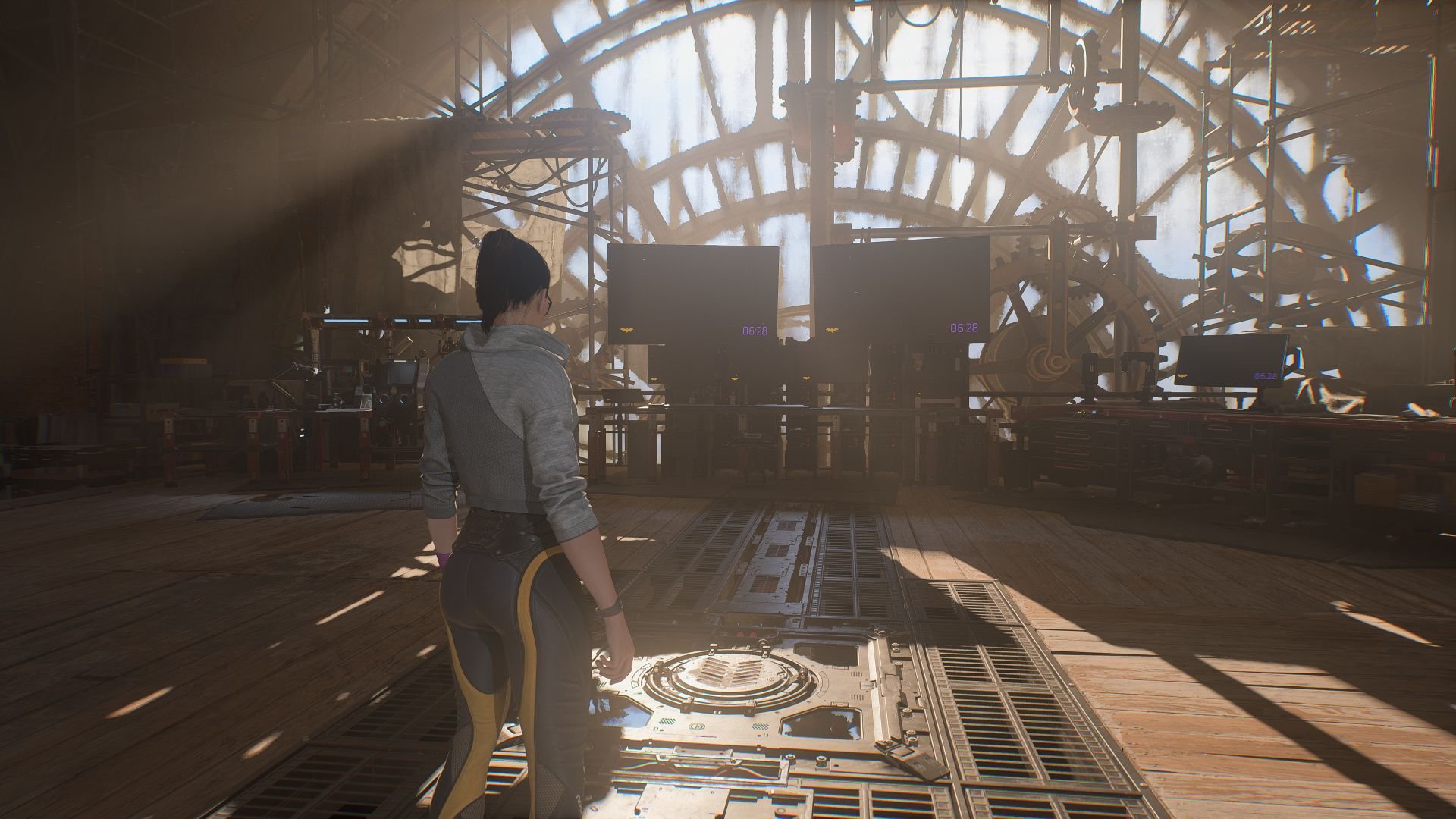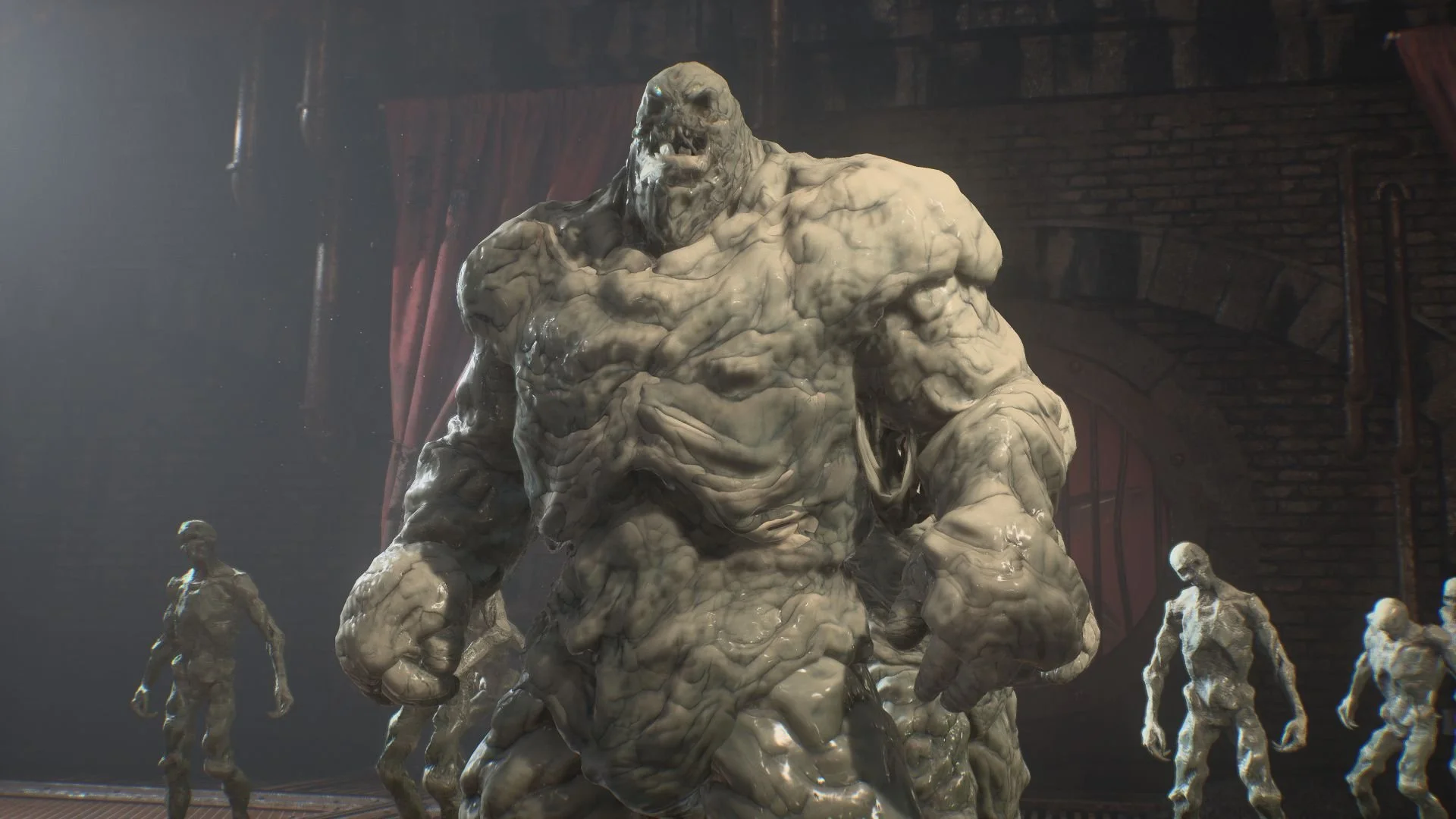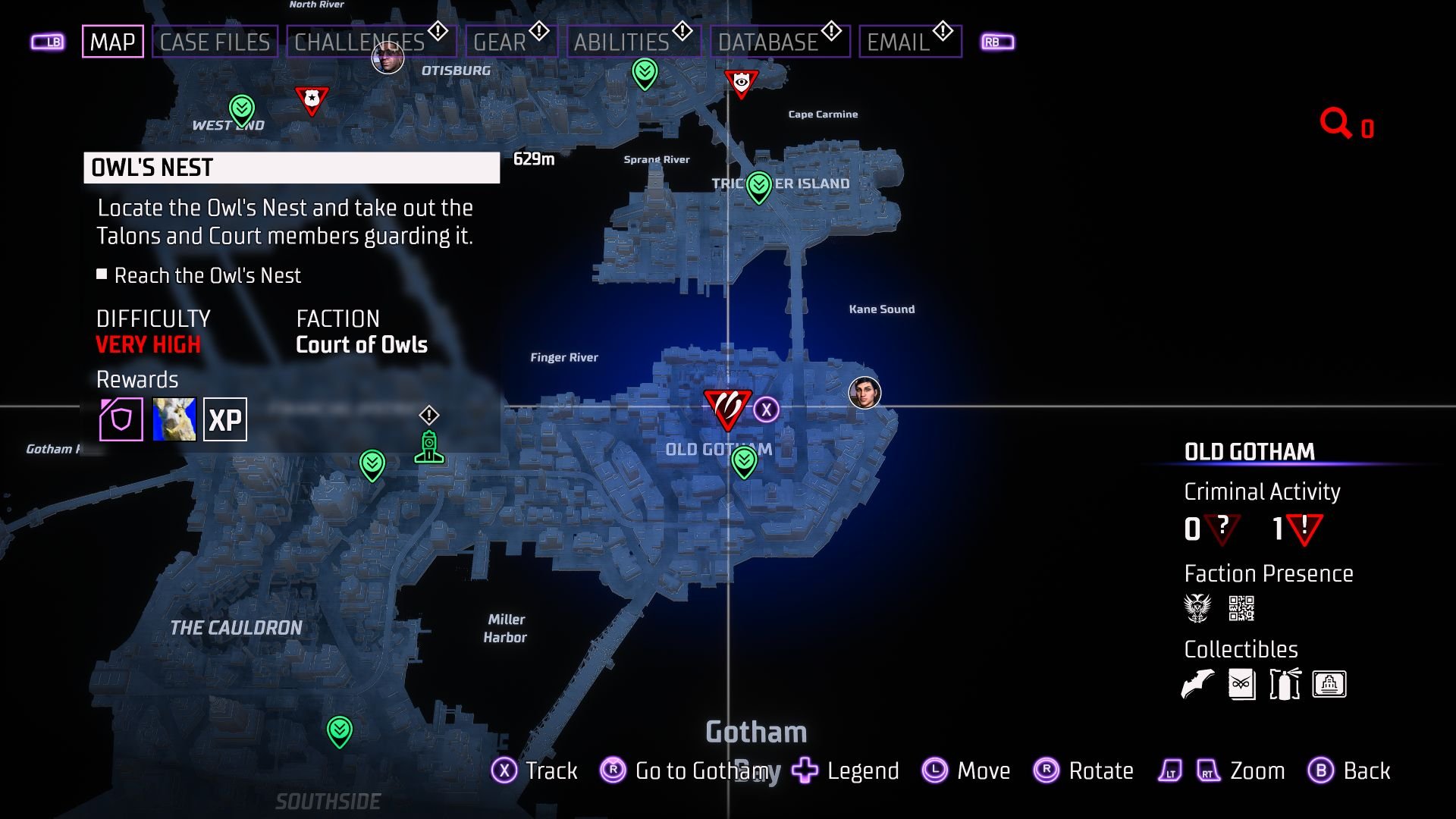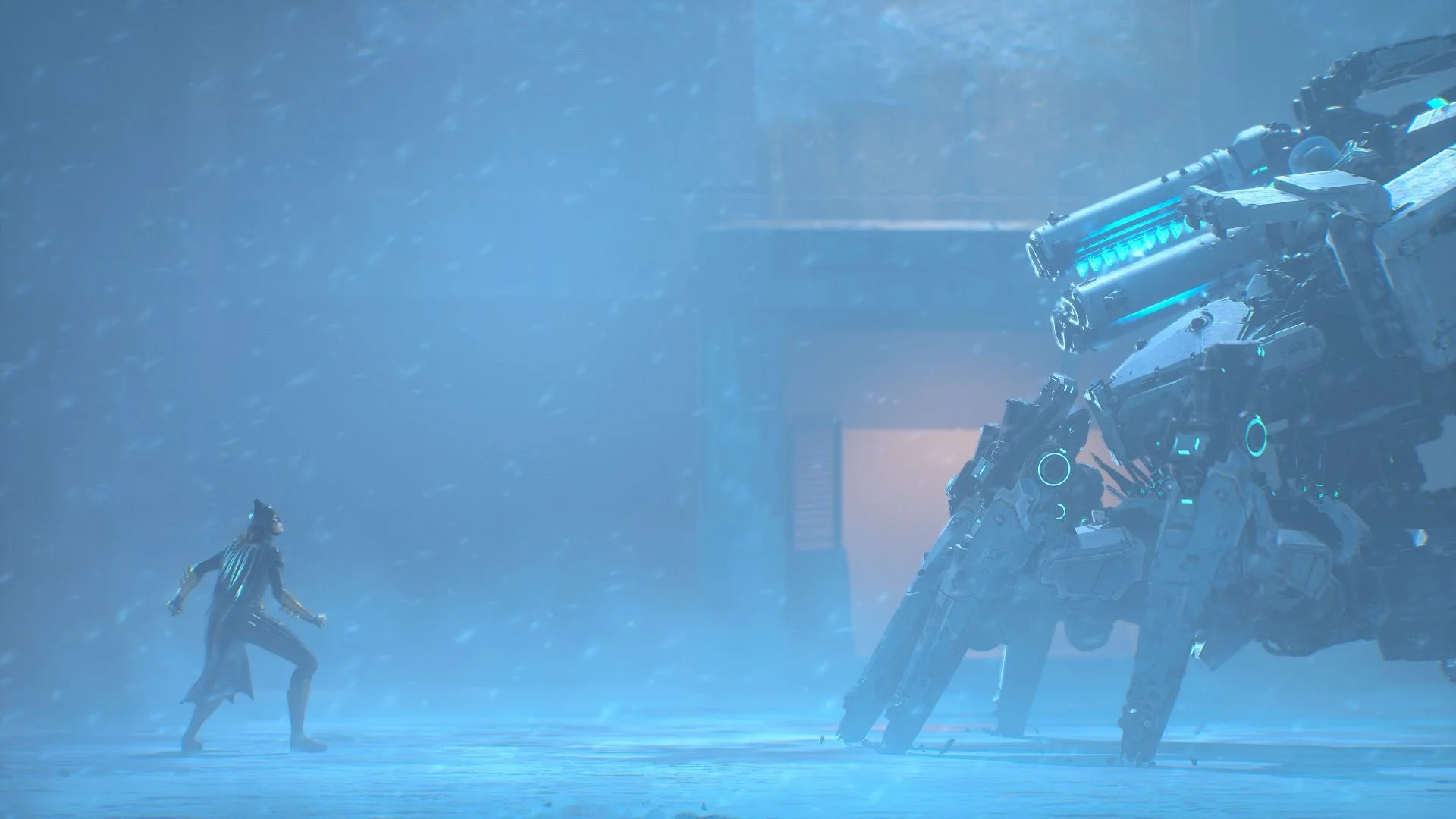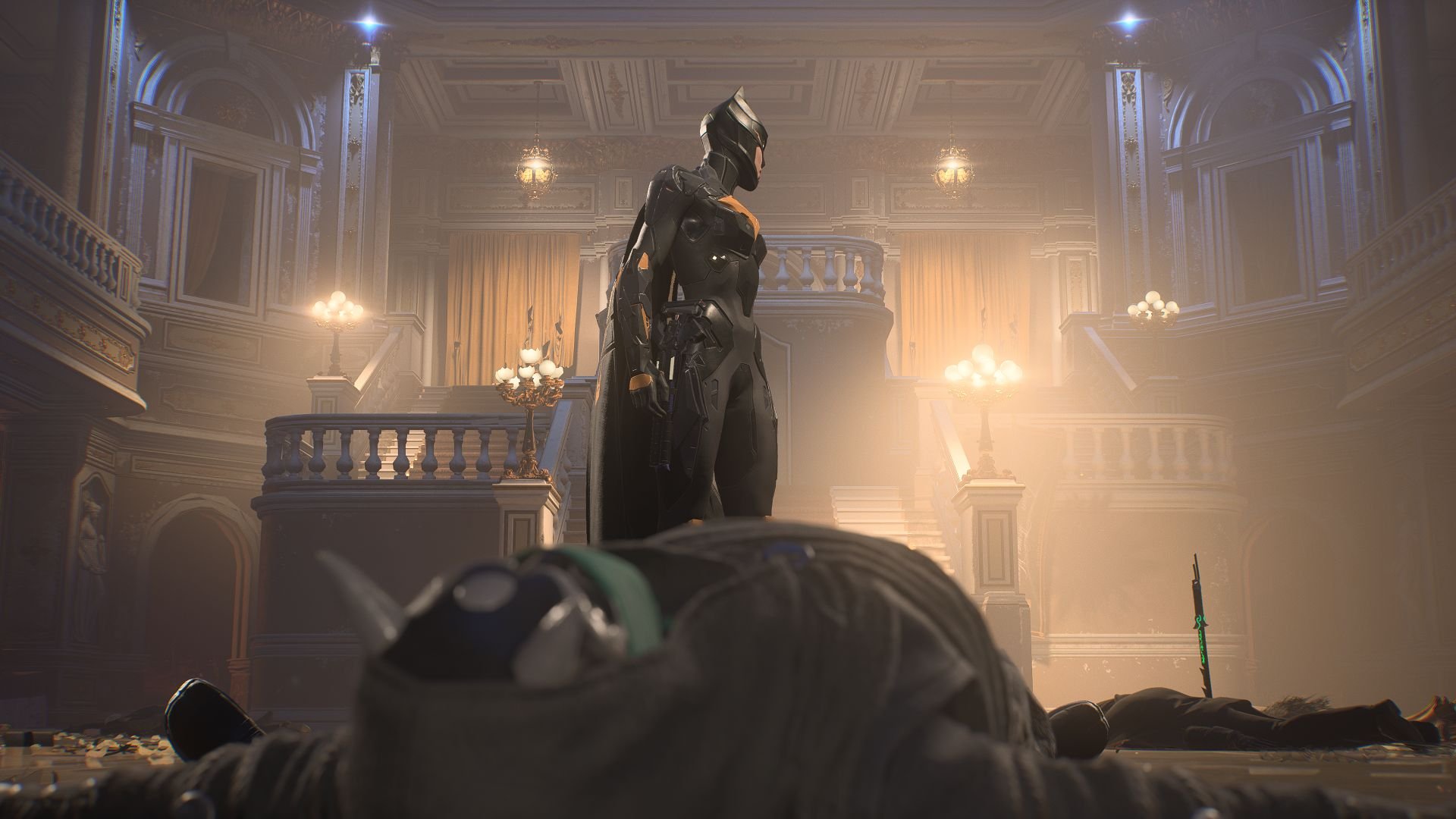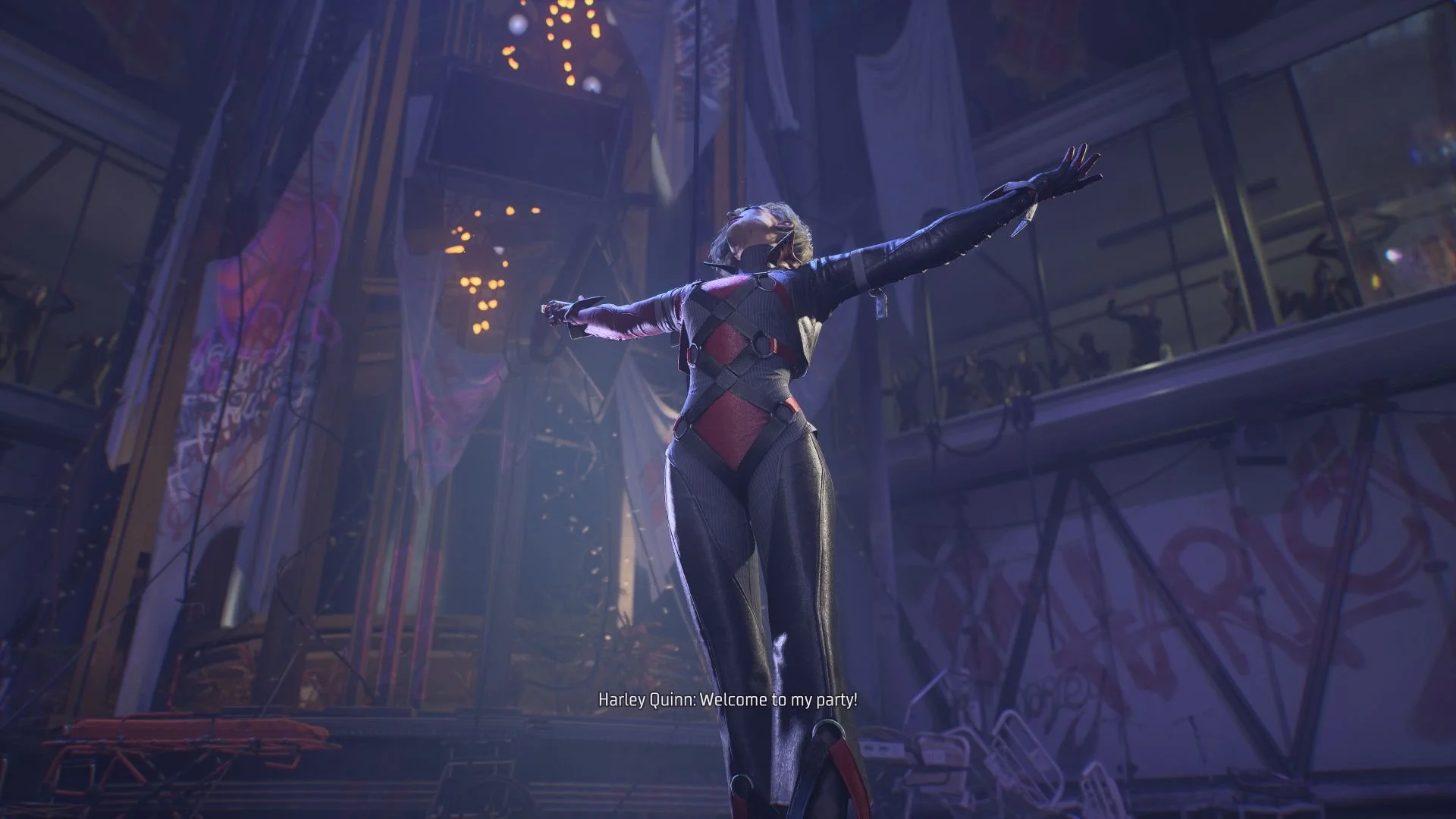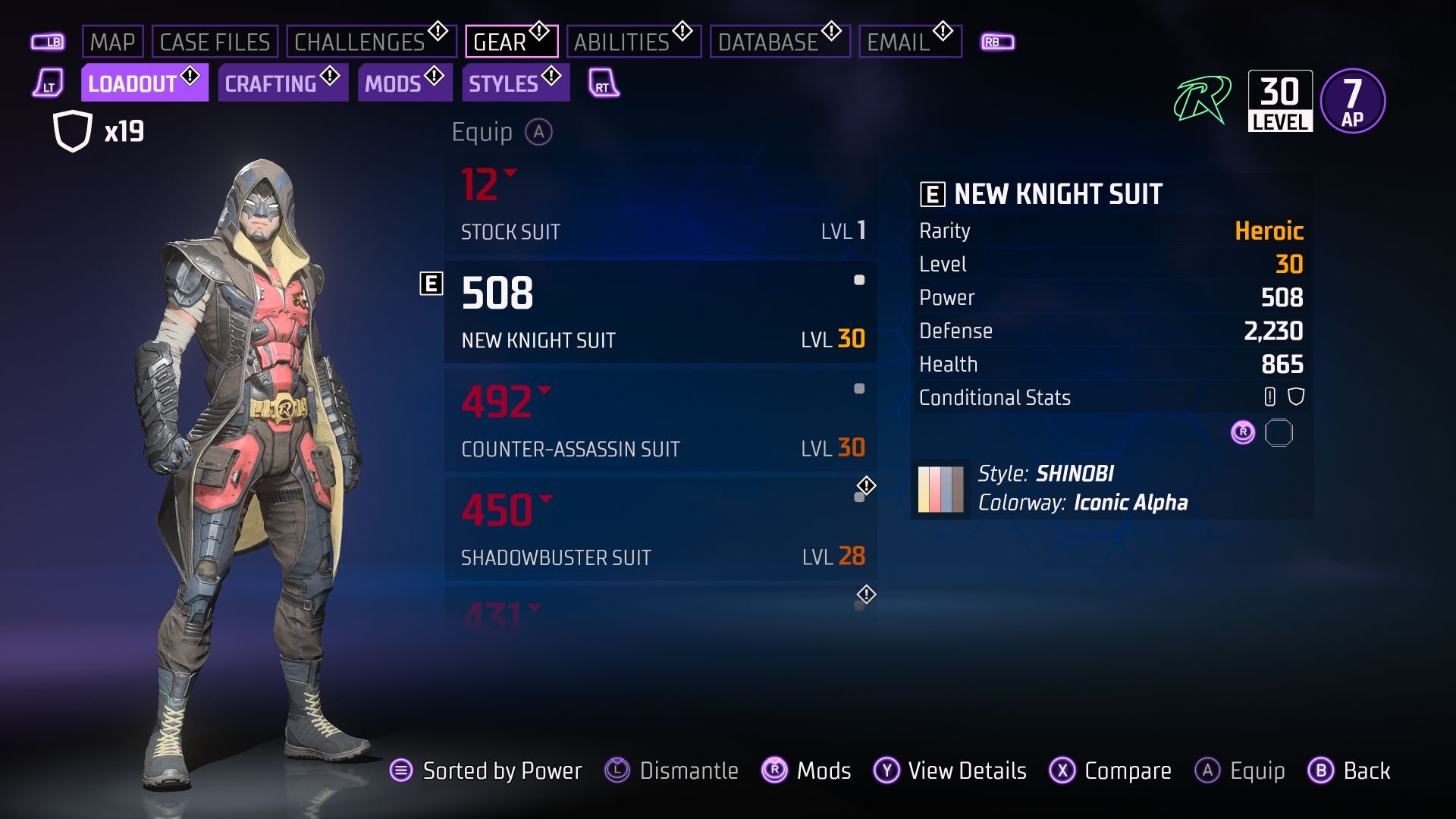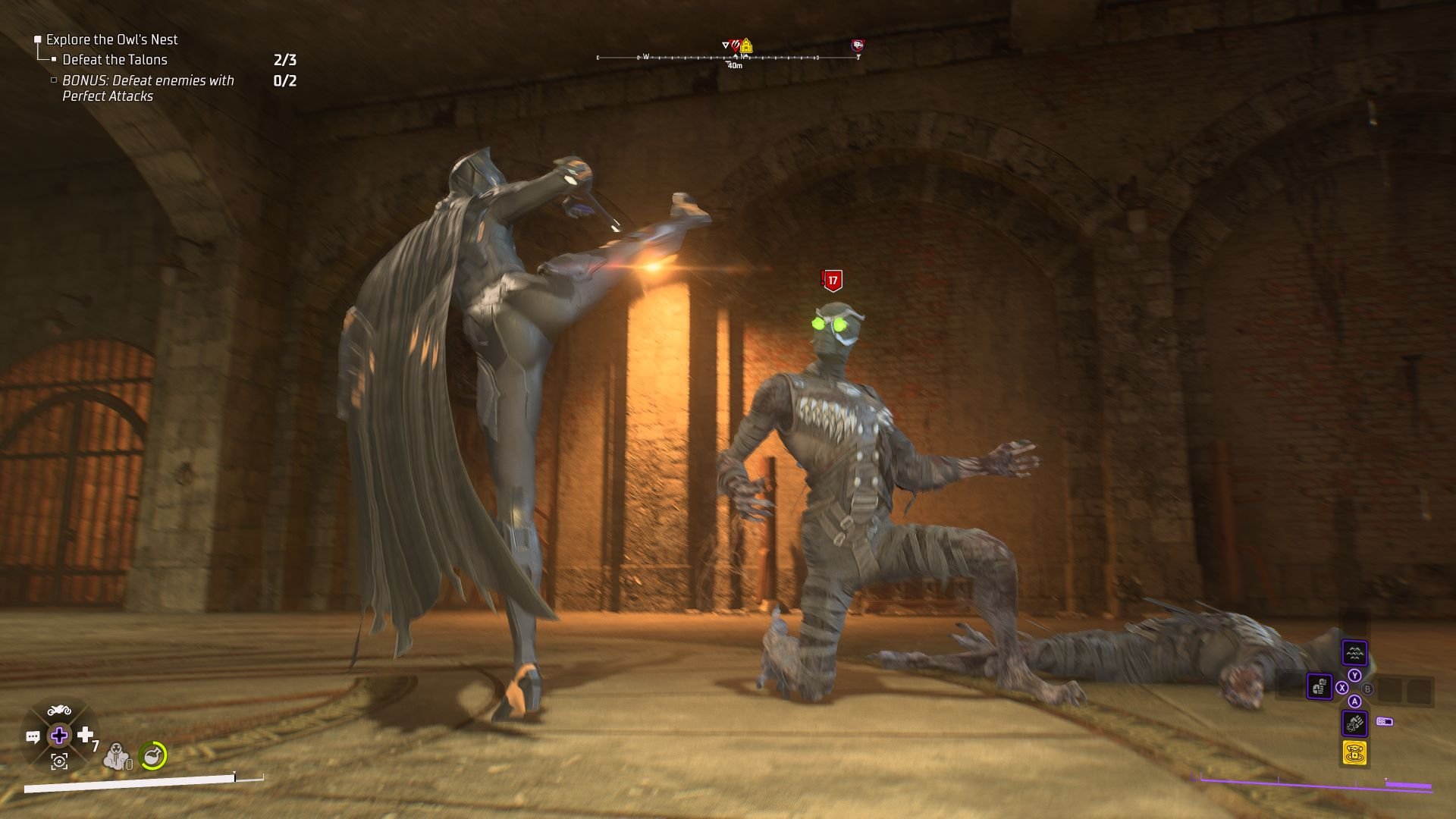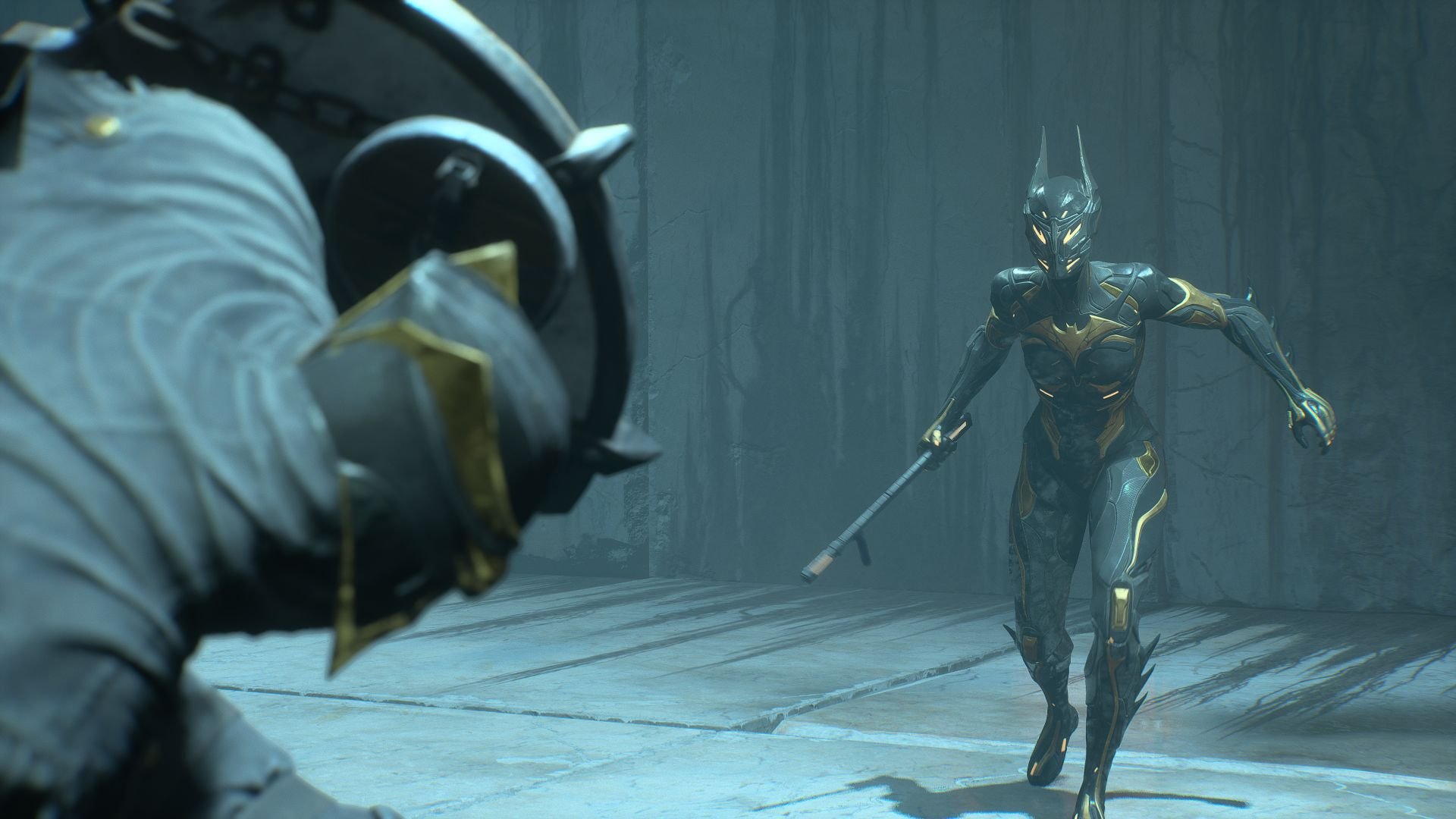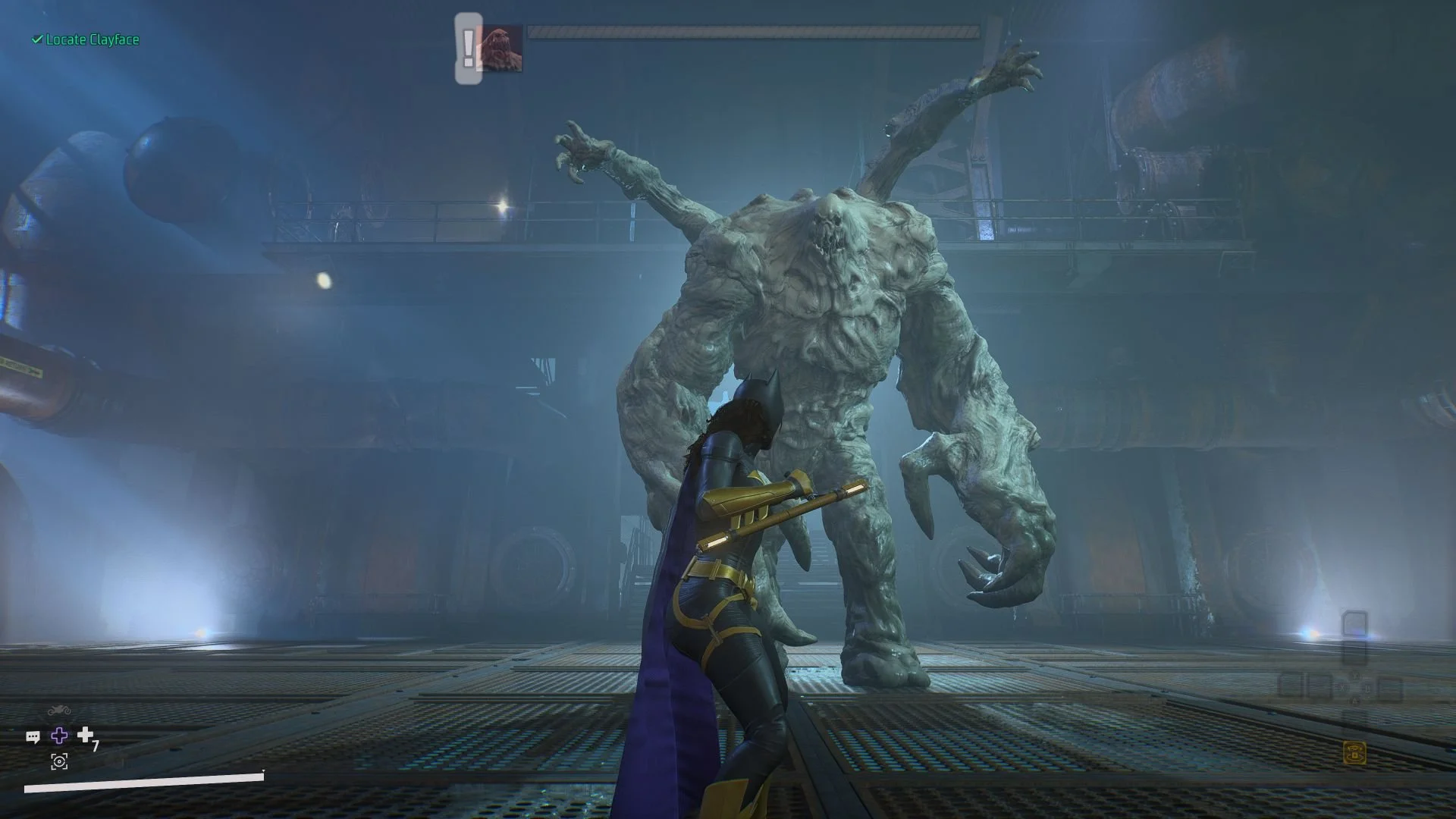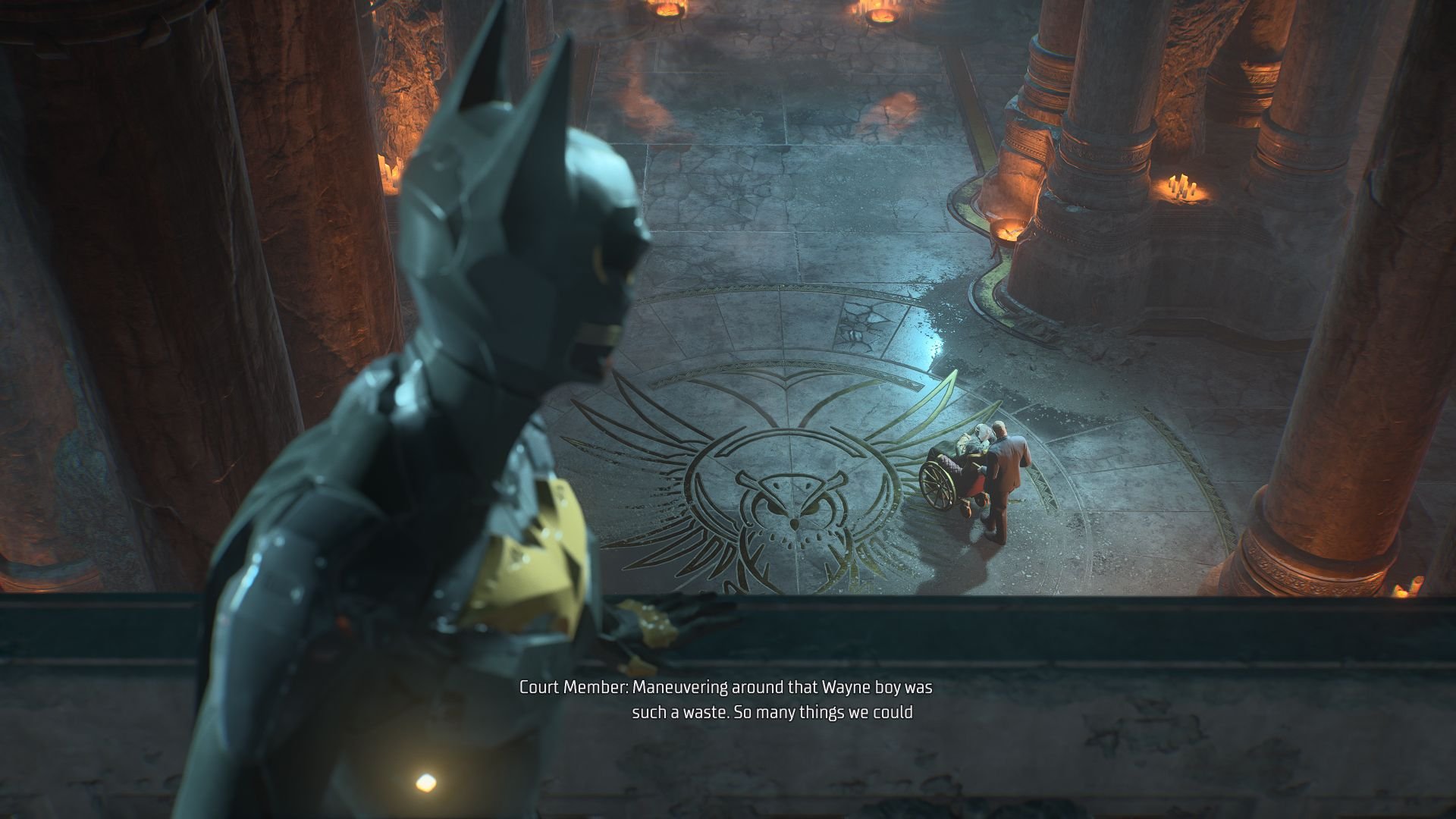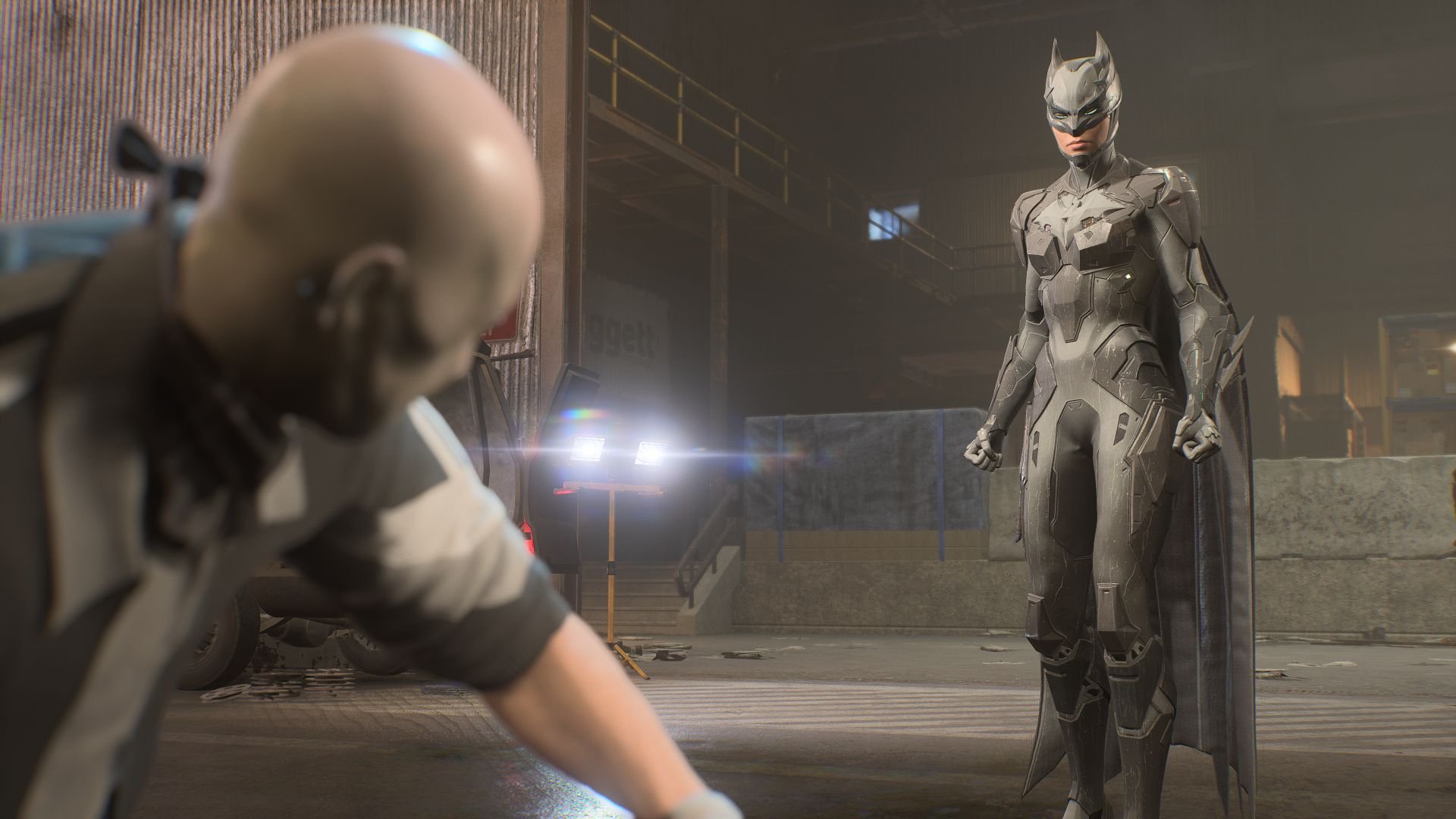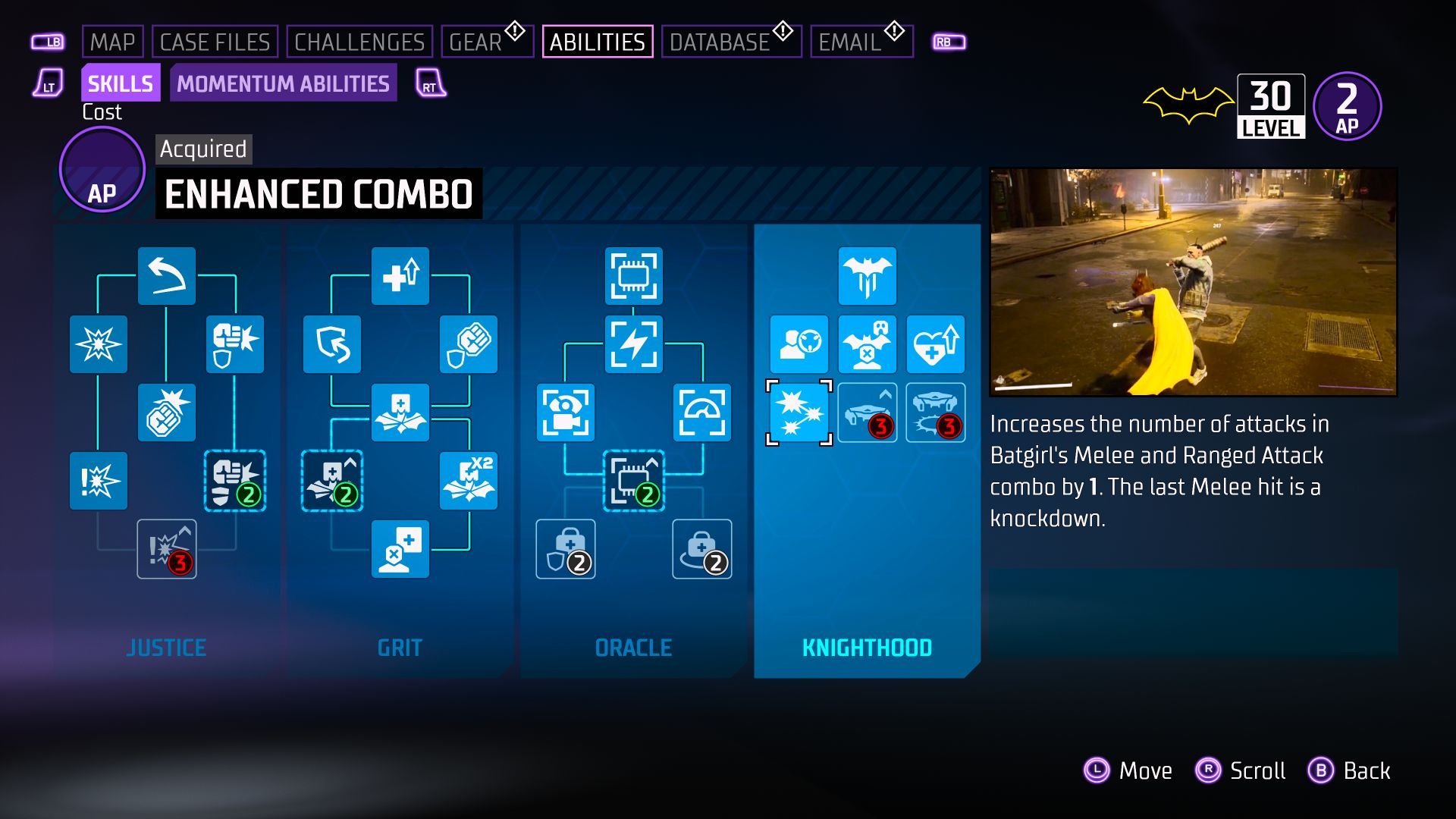In the Shadow of the Bat.
Gotham Knights, much like its central cast, was always going to live in the shadow of Batman. While it certainly attempts to do its own thing, the DNA of Rocksteady’s previous work is a hard thing to escape, regardless of the efforts made here to distance itself from that beloved trilogy. While Gotham Knights succeeds in creating a fairly enjoyable adventure, for what it is, its clunky and unforgiving controls, copy-and-pasted objectives, and uninspired loot system sadly hold much of it back.
When Gotham Knights was first revealed, we were told that the game would take place in a Gotham that had recently lost its Dark Knight. The four heroes in Batgirl, Knightwing, Robin, and Red Hood, now have to contend with a Gotham that has lost its great protector. As the team attempts to put together the pieces of their mentor’s final mission, they stumble across the Court of Owls, an ancient and mysterious outfit that has ruled Gotham from the shadows, pulling the strings to control the city to suit their needs.
While I won’t dive too much into the story as once certain factors come into play, you’ll see exactly where this story is going. While I certainly enjoyed several aspects of it, despite seeing the end of the game a mile away, the dynamic of how the team is coping with the loss of their mentor is rather well done, especially at a key point later on in the story. There are several little moments that each character has that feel well executed, and I really wish the game had more of them.
While I had never read the entirety of the Court of Owls run, I do feel somewhat disappointed in how they were handled here. Before we encounter them, they are nowhere to be seen in Gotham and once they have been revealed to us, they show up in locations that remove any concept of them being a simple ghost story, meant to scare the citizens of Gotham. And, for as much as they attempt to feel like the be-all and end-all of Gotham’s elite, they end up being just another gang, pulling off crimes right out in the open. And, to be fair, another faction present in the game tends to suffer that same treatment, even if I enjoyed their arc far more.
While there are side stories alongside the main event that features Harley Quinn, Mr. Freeze, and Clayface, they all start strong but fizzle out in the end with encounters that highlight the clunky movement and one-note combat systems and are generally not that fun. While the chase scene at the end of one such encounter had promise, it sadly doesn’t live up to what could have been an engaging and well-put-together confrontation. The actual content built around these missions is at least sizable and details some elements of what Batman was up to before his death. However; these stories ignore all of that in order to make it a simple hero-versus-villain arc that isn’t anywhere near as interesting.
While Gotham Knights can be a single-player adventure or one where you and another friend can tackle the story together, I can’t help but shake the feeling that this started out as a game akin to that of Marvel’s Avengers and then was stripped back considerably once SquareEnix’s colossal gamble failed to perform. While there are no daily missions or costume storefronts, the instanced gameplay and side content that feels truncated for length clearly show the signs of what was likely meant to be more.
As it stands, Gotham Knights has you prepping for your nightly patrol while in the daytime confines of the Belfy, your secret base high atop Old Wayne Tower. It is here where you’ll be using the Batcomputer to detail upcoming mission objectives, tool around with your abilities, and workshop your loadout. You can also use the training area to refresh your skills and master the few outlets of combat available to you. Once you have crafted your gear, applied your mods, and spent your ability points, you’ll take to the streets of Gotham, attempting to shut down the sudden rise in crime that has spun out of control with the loss of the Batman.
Now, there is a somewhat satisfying loop here, one that does largely work. Gotham is split into its notable districts that are controlled by either the Mob, Freaks, or the Regulators. As you enter into your patrol for the night, you’ll have premeditated crimes to take on, missions to complete, or side characters to track down. In regards to the latter, these are largely built on the various challenges you have to complete as traversing across town to chat with them ends with a single line of conversation that simply doesn’t go anywhere. This hollow effort of how this is presented is laughable. While the story objectives remain, even if you return to the Belfry early into your patrol, the randomized crimes around the city will refresh for your next outing.
One of my biggest gripes with most open-world superhero games is how the crimes feel far too scripted; static events that never feel organic. While Gotham Knights doesn’t exactly solve this in any meaningful way, it certainly puts its best foot forward to at least attempt it. This is done by having smaller bite-size crimes occur all over the city as you traverse it. These are not substantial efforts by any means as they can be completed in a minute or two, but the way they just pop up really plays off how dangerous Gotham is. Again, this is nothing to really talk up, at least in how basic this system is currently, but this is something that certainly should be expanded upon for every open-world superhero game going forward.
Ripping around on the batcycle and leaping into the air to stop an armored car robbery was consistently thrilling, as was attempting to beat the clock on stopping the variety of bomb threats, organ trafficking, or even stumbling across the odd Batarang that was left by their mentor. The issue I have with these activities is that the more involved ones always take place in the same dozen locations over and over again. For as big as Gotham is, the reuse of these locations can make it feel dramatically tiny as a result. The fact that Gotham has only a small handful of these types of locations simply continues to show that there was likely meant to be a much wider offering of what the city was originally meant to have in store for the player.
Gotham Knights has you taking on the roles of either Batgirl, Robin, Knightwing, or Red Hood, each playing differently enough in their combat and how they traverse the map. Nothing here is night and day different, but you can certainly feel the difference once you’ve really spent some time with each of the cast. My full playthrough was via Batgirl, but I took each of the other characters out for a spin to grasp just what made each of them tick. For traversing Gotham, Batgirl has the typical gliding via the cape, Robin can use a teleport system fueled by a Justice League satellite, Knightwing has a personal glider, and Red Hood has a mystical leap that acts almost like a supernatural double jump, one that allows him to just bounce high atop Gotham.
Each of these traversal systems is unlocked after completing a few objectives, such as simply stopping ten crimes as well as a few minibosses. Personally, I feel this limitation sets a poor pacing issue with really opening up Gotham from the get-go, which would have benefitted the start of this adventure greatly, especially as these are not new recruits but sidekicks that have clearly been doing this for some time now. Otherwise, you’ll have access to a fast travel system that has to be unlocked by scanning a series of drones all over Gotham.
In the previous Arkham games, the grappling hook was used to not only navigate Gotham or the Aslyum but to also zip Batman up to nearby ledges to get the drop on his enemies. While much of that remains true here as well, very few environments really take advantage of it, usually having limited options for its use or sometimes not at all. While I always found it odd that the locations in Rocksteady’s games would have so many anchor points high atop each room, such as gargoyle statues that often felt so incredibly random in their inclusion, they served a purpose to their gameplay that just isn’t here. There are countless areas that rarely feel designed around stealth, often having you just out in the open or hiding behind a platform or wall.
When it comes to using the grapple shot to latch onto buildings as you traverse the open city, this is where Gotham Knights falls flat on its face. Latching onto the edge of a building or platform is as easy as pressing LB to pull you toward where the cursor exists. You can press A to have your approach end in a jump, which is perfect for continuing your momentum and catapulting you even further. However; the cursor will often move around if you move the camera even an inch, and will see you being pulled in a direction you likely did not want. This is the central reason why I refused to continue with the time trial activities as they became so unbearably frustrating to press LB to target a platform directly in front of you and then see Batgirl being pulled up and behind me to the building across the street. This is something that consistently happened throughout my entire time with the game and something I have discussed with friends as well as watching various personalities play the game online and see firsthand their own frustration with the grapple system.
Another annoyance when it comes to precision is the targeting cursor for selecting something to interact with. This is how you open chests and interact with computer terminals, people, and other various objects. There are missions where you’ll also have to beat the clock as a timer is counting down and if you are not perfectly aligned with what you are meant to interact with, you cannot hold A to select the interactable object. Now, you can move your character to line up with the object, but each character has this multistep animation that prevents any sort of small basic adjustments. It’s not quite the tank controls of old-school games like Tomb Raider, but it feels very much in that wheelhouse of having to almost readjust your position entirely to select something that is literally right next to you. Had holding A simply interacted with the object nearby regardless of your exact positioning, then this entire issue would fade away.
Your progression of the story is handled through case files for each of the main chapters as well as your personal run in’s with Harley Quinn, Mr. Freeze, and Clayface, with the latter having an extremely short and lacking questline. While the basic progression is sometimes as simple as heading to an objective and playing out the scene, some of this progression is locked behind trivial matters such as interrogating a random criminal on the streets, forcing you to track down a particular gang member over and over again. This also plays into the challenges which require you to stop a variety of crimes or defeat certain gangs and enemy types. I don’t mind the challenges as it keeps you busy throughout Gotham, and rewards you with various crafting items, but having that connection to the main story progress feels incredibly lazy.
Gear plays a big part in keeping you alive and being able to dish out damage to the more challenging foes. While I do like the idea of having this sort of game built around loot, it doesn’t feel as well executed as it could have been. Displayed throughout a menu that has three entirely separate font sizes to illustrate the gear type, its power level, and what exactly you have equipped, loot here is built around simply equipping whatever moves the numbers up. Each gear item works towards a certain build or function, with numerous icons and stats that feel like they have depth for depth’s sake. As you navigate these menus that honestly feel like alpha-build placeholders, you’ll choose your gear items that have stats that vary from their level, power, defense, health, and various conditional stats like increasing armor and critical chance when the wearer has less than half health.
Attempting to add more depth to the gear system is a series of uninspired mods. They are split between Suit, Melee, and Ranged. Suit mods add power and health, Melee mods add power, critical damage, and elemental properties, and Ranged mods act exactly the same as your Melee offerings. As you progress throughout the story, you’ll unlock a ton of these mods, so many that you’ll need to fuse together your favorite mods constantly to boost their power. Honestly, this system truly serves zero purpose as the core gear items could have easily had these types of stats included. Had these mods affected your core abilities such as occasionally throwing out a second Batarang, turret, or additional glide time, then they could have actually meant something on a gameplay level.
As you beat up bad guys and open up loot chests all over Gotham, you are going to earn resources to craft new gear. You’ll first need to track down blueprints to craft the exact item you want and finding those is about as efficient as your grapple shot. I tackled nearly everything I could find in both story missions and the random activities around Gotham and I still wasn’t able to track down every blueprint for Batgirl and even less so for the other members of the cast. There are transmog outfits that shortcut you to make your current getup look the part, but having a legit crafted suit allows you to change smaller features such as the type of cowl, symbol, gloves, and boots that you can use. Personally, I adore the small tweaks you can make, but each suit type only has three cosmetic variants. You can also track down colorways that change the color of each suit, but only a few of them feel suited to really being in character.
Combat itself is a mixed bag, especially knowing that the Batman series of games is largely responsible for the best feeling superhero combat to date. Granted, I wasn’t expecting this group to fight as efficiently as the Dark Knight, but it still lacks in polish and speed, especially as even regular punches and kicks feel slow to react, to say nothing of the long delay for your heavy strikes. Each character has access to a melee attack and range attack, each with heavy alternatives as well as momentum abilities that you’ll unlock that grant you powerful strikes and other abilities such as throwing out a storm of Batarangs, shooting off fireworks, or popping out a small mini-turret that shoots at nearby threats. These abilities are fueled by Momentum, which is earned as you fight criminals during combat.
Because combat is essentially the manipulation of just X and Y, or through the use of your Momentum abilities, it lacks a lot of depth. You do have an evade, but it rarely helps you apart from narrowingly missing an incoming attack. The game lacks the finesse of dancing around enemies or really flowing into the next effective combo string. While you can hold the heavy melee attack button to spring it on the foe in front of you, it will often attack someone behind you since they would be a pixel closer to you. You do have the ability to throw enemies, but unless they are unaware of you, you have to lower their health to extremely low levels, which can also translate into either pulling off an interrogation or a traditional throw.
Additional combat systems work around guard-breaking enforcers with large shields, piercing through armored attacks, using area of attack skills to stop nimble enemies in their tracks, to using fear to decrease the attack rate of nearby enemies and proceed to make them terrified, which to be honest, happened a single time for me. There is also elemental damage, effects, and resistances to keep in mind, but with how one-note the combat system is here, you won’t really take much of that into account with what you’re actively doing here.
Throughout combat and exploration, you’ll have a blink and you miss it detective vision. The AR Pulse highlights crimes and holding it down allows you to target enemies, but you have to mark them individually with a cursor that is sluggish to move around due to the 30fps nature of the console versions. This process for marking a whole building’s worth is incredibly annoying and so time-consuming that it is far easier to just jump down and take them all on out in the open or attempt to stealth your way around the environment, should the location even allow for it. Exploring Gotham and using the pulse to reveal the crimes around you only lasts for about a second, so you’ll constantly be spamming it down as you navigate your way to the nearest activity.
One element outside traditional combat is these small little crime scenes. While the random ones that happen all over town are passable at best, you have a few substantial ones throughout the main story that are a nice alternative to just simple fist-a-cuffs with various gang members. These have you reading through the clues in front of you, trying to connect various things to find the solution. One such event has you looking into an email that details how the scientist relied too heavily on one ingredient and by using the process of elimination, you can deduce which is the correct response. These little crime scenes are few and far between but bring out the detective part of these adventures in a fairly enjoyable activity.
A great deal of the discussions surrounding Gotham Knights has been about its framerate and that the game dropped its last-gen versions, an act that likely was about the cost it would take to optimize those older platforms. The game itself doesn’t really feel current-gen at all, with environments and character models that easily could have been possible on PS4 and Xbox One. Optimization seems to be at the heart of the matter considering the 30fps range on consoles and the inconsistent performance on some PC specs, which is a far bigger issue surrounding gaming at this point than any talk about the Series S holding back any part of this industry. Apart from the AR cursor being a tad too touchy and slow, I never had any issues where I felt a more smoother framerate would have solved the game’s other glaring issues. Combat, loot, and the god-awful menu systems, as well as navigating the city wouldn’t have suddenly been improved with a constant 60fps or previous generation consoles having their own version as well.
As it stands, Gotham Knights looks fine. I’m not terribly impressed with its visuals from a point of view of being blown away, but Gotham does look pretty darn good, despite so much of it looking the same. Areas like the Iceberg lounge could have been gaudier, louder, and more overbearing, but it’s basically a bland-looking nightclub shaped like an iceberg with a few lights out front. It’s things like that that permeate throughout the city and doesn’t really have its districts stand out as much as they should. The foggy nature of the city’s skyline, mixed with the few neon lights do work in the game’s favor, but there isn’t a single part of Gotham that I can walk away with feeling like they nailed it.
Gotham Knights is by no means a bad experience, and frankly, one that I do hope continues in some fashion. However, saying that, whatever would come next certainly needs more done to address its issues down to its core and develop an experience that feels as polished and fulfilling as it should have been. There needs to be a meaningful difference between the roster, activities that don’t feel like the same event constantly refreshing on the map, and a progression and loot system that is more than just paying attention to the numbers going up. Gotham Knights has a good foundation here, a concept that is ripe for exploring, and a license that can fuel stories for years to come.
Developer - WB Games Montreal. Publisher - WB Games Interactive Entertainment. Released - October 21st, 2022. Available On - Xbox Series X/S, PS5, Microsoft Windows. Rated - (T) Blood, Language, Use of Alcohol and Tobacco, Violence. Platform Reviewed - Xbox Series X. Review Access - Gotham Knights was purchased for review.


